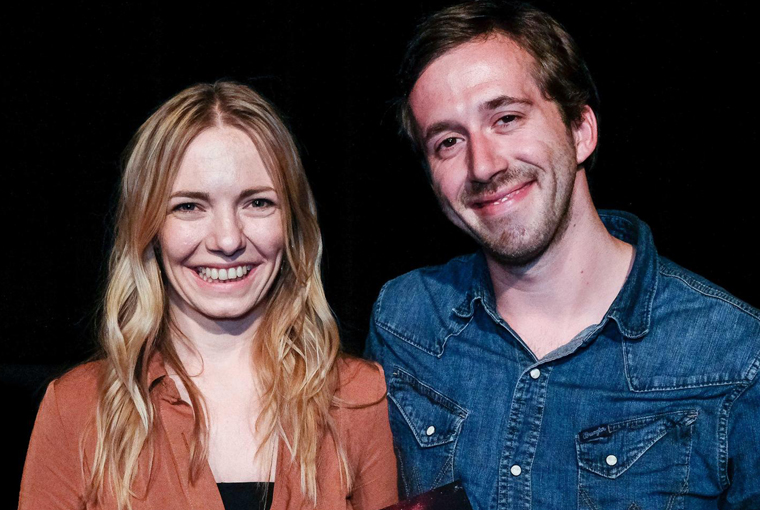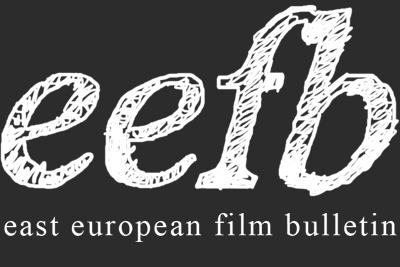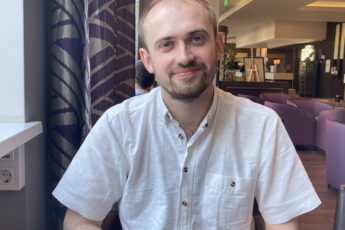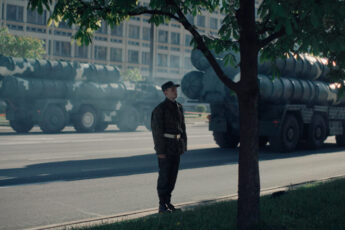
We met filmmaking duo Elsa Kremser and Levin Peter at the Sarajevo Film Festival (15–22 August) to discuss their film “White Snail,” which recently premiered in Locarno. Kremser and Peter relate how their project developed, how they found their protagonists, and what the filmmaking process was like.
To start off, how did you come up with the idea for your film? And how did the project take shape?
Kremser (EK): I met Mikhail [Senkov], our main character, about ten years ago. I was introduced to him as a painter, as an artist. And his paintings inspired us. We spoke a lot about them: they depict bodies and flaws, death, but also life and pain. Those conversations stayed with us, and we decided to make a film with him. Not fully about him, but with his participation. That was the starting point, and the project slowly evolved from there over the past decade.
Peter (LP): And now, so much time has passed. It’s very touching for us to see that, in Locarno, these two people were recognized in this way. When I think back to the last ten years, I really like how it all happened. Elsa came back from Minsk from this encounter with Misha and told me about him. For a while, we would only look at his paintings. So in a way, my first encounter with Belarus were his paintings. That initial moment never left me, it carried through the entire shoot. His paintings made me want to see the world through his eyes, even though I knew it came with a high risk of pain.
So how did you get from that first encounter – seeing the paintings – to actually making the movie? And your two protagonists – Mikhail and Marya Imbro – were also both non-professional actors, right?
EK: Yes, exactly, they had never acted before. For many years, we only talked. We talked with Misha, and we talked with each other. We kept returning to the country, trying to understand: what kind of place is this, who is Misha, what does it mean to work in a morgue, what does it mean to paint in this way?
Eventually, we had the idea of a young woman encountering him. So we began casting for the female lead, and we met Masha [Marya Imbro] very early on. We actually found her through social media, because we had no other way to reach young women in Belarus from abroad. Once we met her, her world opened up to us, full of modeling and all these other things.
From there, we began writing the script. It was a long process. We kept rewriting it over and over. This took many years because the world around us was constantly changing. They themselves kept changing too, growing older. We were still writing up until the first shooting day. In fact, we were still rewriting during the shoot. In the editing room, I’d say there was still another layer of rewriting, as we shaped how to narrate the film.
What happened on set? The dialogues feel so authentic. How much of that was actually developed through improvisation?
LP: A lot. For example, take the first scene where Masha comes to Misha’s house and sees his paintings for the first time. They start on the street, then walk up the stairs, into the house, through the kitchen, and finally into his room. Technically, everything was prepared in advance: the light was set up so we had 360 degrees of freedom. But in terms of performance, the script only gave a very brief description of the goal of the scene, of what we wanted to achieve.
The idea was that this would be the first time Masha was exposed to his art. Before shooting, we would talk with her alone for about an hour about what we wanted in the scene, and then separately with him for another hour – never together. They weren’t supposed to know what we told the other, because then there would not have been a sense of secrecy anymore.
EK: And this also meant that Masha had never been inside the fictional apartment before. We stayed with her outside on the street while the crew prepared inside. When she approached him, he had already been painting for about an hour in real life, so that when she knocked on the door, everything she encountered was authentic. And we went with her to the door and went inside.
Of course, you can only do this in the first take. Much of what you see in the film is actually from those first takes. We did do several takes, sometimes even ten of them, but a lot what you see in the film is actually the first take. It is the first time that something happened. There were repetitions, but the core narration is mostly the first take.
LP: The shooting process in those scenes is a good example. We gave Masha simple tasks (like provoking Mikhail a little, to get him out of his comfort zone), while at the same time reminding her to be genuinely happy about finally being invited into someone’s home, since she’s a loner. From there, the way they shaped the dialogue was largely up to them. Afterwards, we would discuss with them what worked and what we did not like at all.
EK: For later scenes, we gave them more ideas, sometimes even specific words. But still, most of it came from them. The scenes are deeply rooted in their real lives. Our goal was to create situations that would provoke them to tell each other things they had once told us privately, maybe a year or three years ago.
How much of the set was curated, and how much was authentic?
EK: Both main apartments were completely built sets, made solely for the film. The exorcist’s place was entirely documentary. This is all real. We didn’t change a single stone there because it was important to the exorcist to keep the energy flowing. She really believed in the demons and in needing to take them out of Masha.
As for Masha’s mother, she’s an actress, but she was very brave in accepting our approach to filmmaking. She actually moved in with Masha into the fictional apartment. They lived together for several weeks, cooking dinner, and living the life of mother and daughter for a few weeks during the shoot.
LP: The model school, for example, there are maybe 10 to 15 of such kind of model schools in Minsk, and they really look similar to the one in the film. The two trainers actually do this for a living. We were overwhelmed by them, so we were very lucky they agreed to participate in the movie. As for the models, we cast around 300 models and eventually narrowed it down to the 10 to 15 we wanted to work with. So what you see is real, it just looks a little different for the screen.
EK: We did make some changes for cinematic reasons. But at the morgue, for example, it’s a real morgue in a real hospital. We were fortunate to be allowed to shoot there in this half-documentary, largely fictional way. For research, we also worked in the morgue with Mikhail and our cinematographer, to understand the movements and to develop a cinematic language in such a place. In most films, morgues are shown like crime scenes, and it’s not so easy to get away from all those clichés.
Working in Belarus right now is not the easiest task. What difficulties did you face, and how did you cope with them?
LP: The biggest challenge was simply traveling. The borders are quite closed, so there was a lot of complicated logistics to be done. That was the first layer. The second difficulty was building a working structure inside the country. This was only possible because we found an amazing producer in Belarus who, from the very beginning, believed in the story. He saw the opportunity of an encounter between us, the people we brought in, and the people in his own country he felt we should meet.
Of course, shooting in Belarus also meant we had to declare in advance where exactly we would film. It was not easy at all; the whole process was tense – personally, mentally, and in terms of whether we would even succeed in making the film. Part of the shoot also took place in Latvia, so it wasn’t entirely shot in Belarus.
Looking back, I don’t completely understand how it all worked out. But when I think about it now, I think about the people there who were passionate and hungry to make this film with us.
There’s also a sense that the film has something political about it, that it’s rooted in the environment and the people you worked with. Would you agree?
EK: For us, the main feeling when talking about Belarus was that we wanted to show images from a country where the ones we usually see are so filtered. It’s a very isolated country, and not many stories reach us anymore. We had the chance, a long time ago, to meet these two characters, and we simply couldn’t let go: first from them and their personal story, and then from how it became our story too.
Obviously, we asked ourselves several times whether it was still possible to make this film under the current circumstances. But we didn’t want to ignore this part of the world, this country, even if the borders are closed and the isolation is very strong.
LP: Over the long time we spent in Belarus, we realized how much the environment affects the body in so many different ways. Military or militarized actions are everywhere; not only in Belarus, unfortunately, but across the whole post-Soviet region. That’s one reason why the news in the film is so important to us; it becomes part of daily life.
On the other hand, there’s also this rise of spiritualism, which was a huge surprise for us. It’s very present in everyday life. So many people turn to a spiritual healer instead of a doctor when dealing with psychological issues. All of this comes together.
I was struck by all the images of border crossings – like into Poland – but also the idea of the body as a kind of threshold. And then there are these fairy-tale and magical elements, connected to the spirituality you mentioned. What were your influences here?
EK: In all our work, including the documentaries, we like to play with mythology and dreamlike, fairy-tale images. It’s a way of expressing ourselves that feels very playful. And we just enjoy it in a very simple way.
In this specific case, it also comes from Belarus itself, where spiritual traditions are very present and have a long history. For example, the tree in our film, it really exists there at that spot. It’s a documentary truth. People go there, and they hope to get better by crawling through it.
When we encounter places or people like this, it feels like a kind of cinematic magic. We think to ourselves, “Okay, we need to do something with this.” And then we talk and talk – and cinema comes out of that.
Snails, for example, are obviously a very symbolic animal in our film. We love to watch animals and try to understand: what are they, what could they tell us? How do we look at them, and how do they look back at us?
The snails actually came from a real detail in Masha’s life. Her mother once bought snails for her for skin treatment. They eventually decided not to use them (thinking it wasn’t very clever or cool) but kept the snails as pets instead.
That little true moment sparked something for us, and the idea of the snails kept growing and growing. When we encountered the tree and already knew the snails would play a role, the images you see in the film started forming in our minds. We just wanted to bring that to the screen.
It was fantastic!
LP: Thank you, we also like it. Think of the turtles in Space Dogs [a 2019 film by Kremser and Peter inspired by the story of Soviet space dog Laika]. It’s the same thing. We love that emotion. We hope to create it in every film: that moment, maybe twenty minutes before the end, when the film turns a completely new way. We like to build something where the audience already feels comfortable or thinks, “Ah, I understand it,” and then to turn it upside down again.
You work as a duo and it seems significant that it’s not just one director, but two. And this is also reflected in the film itself. I’m curious what’s it like to work as co-directors? How does your process actually work?
EK: Many people are interested in how this works, but it’s actually hard to explain because this is just the way we work. We’ve made films on our own too, but together, it flows quite smoothly.
LP: It would be cool to watch us from the outside for one hour. I might understand it better! It’s been so long already.
EK: It’s an abstract question. We’ve known each other for sixteen years. We have been a couple for sixteen years. And we have worked together for sixteen years. The moment we met each other, we began speaking about cinema and we fell in love. And that’s basically what we do every day: we still talk about cinema and we are still in love.
LP: One thing I can say for sure is that I wouldn’t have done the snail scene alone. I’m sure of that.
EK: I agree. I would be too shy.
LP: Yeah, me too.
EK: When I have an idea that I think is stupid or bullshit, I feel the freedom together with Levin to just tell him about it. I trust him completely that if it’s really bad, he’ll just tell me, “No, forget about it.” Or he says, “It’s strange, but let’s talk more about it.” And then something evolves out of that. It’s like holding up a mirror to each other and sharing the strangest ideas. A lot of them are not fit to realize but some of them survive and become the cinematic moments you see in our films.
LP: I think it’s both, right? With some ideas, we feel that they work better when put together. Like the snails: we once saw a YouTube video of two snails having sex. We watched it together and said, “Wow.”
EK: “We need to do it.”
LP: And then, a day later, you think, “No, that’s stupid, such a waste.” But that’s how we build things up together and it helps.
The film is about a relationship but also feels like a portrait of masculinity in Belarus: a sensitive man in a heteronormative, authoritarian, and traditional society. What did you want to explore with that? Was gender something you were consciously addressing?
EK: Yes, I mean, it’s really him. And that’s what makes it so surprising: he has this quite tough, even intimidating workplace. His paintings are beautiful but can also be scary. And yet, he is such a sensitive guy. That sensitivity just comes from his character, from who he is.
But obviously masculinity and femininity in cinema are something that moves us and we want to talk about it. I still see so many films where I think it can’t be true that this is a depiction of our society right now. Especially now, with governments becoming more conservative and pushing us back toward these rigid, traditional images of male and female.
So yes, it’s an important topic, especially within the relationship in our film. What I really love about the story we created is the way the two characters listen to each other. It’s not about who is male and who is female; it’s about understanding.
LP: I also have to say what I often disliked about many encounters we had with men in Russia and Belarus was that it was rare that they would listen, especially on the first encounter. I don’t want to fall back on clichés, but it seems like we were being confronted with a culture where it’s common that men speak first, often at length. It’s not unusual that someone stands up at the table and gives a very polemic speech for half an hour, then the next person stands up.
Misha is different, he can truly listen. And that’s very rare. It’s also beautiful, because Masha’s deepest need is to be heard. That’s the first thing, the first longing she has: to find someone who is really able to listen. I think it’s beautiful that we can show that through him, that it exists in his person.
Do you see any chance of releasing the film in Belarus? Will it be screened there?
EK: Under the current circumstances, there’s no possibility to show it there. But we hope a moment will come when it becomes possible.
Thank you for the interview.




Leave a Comment